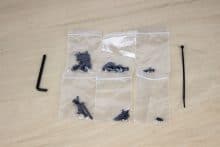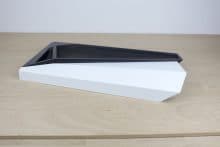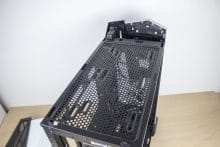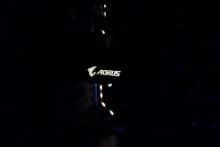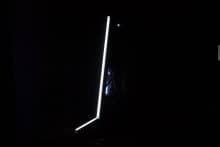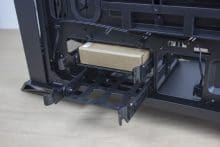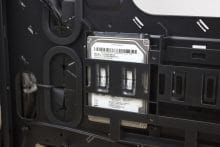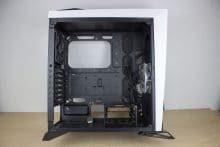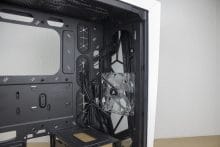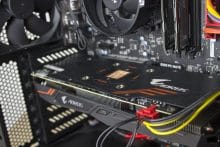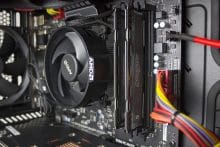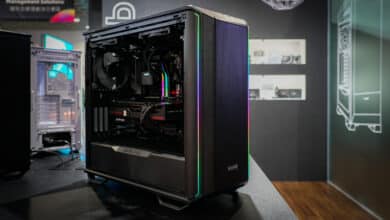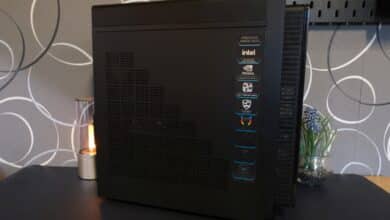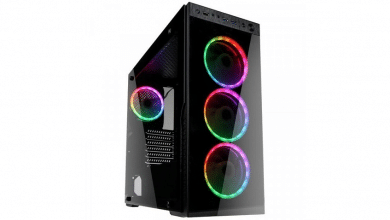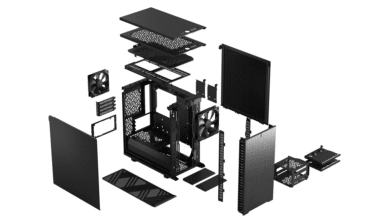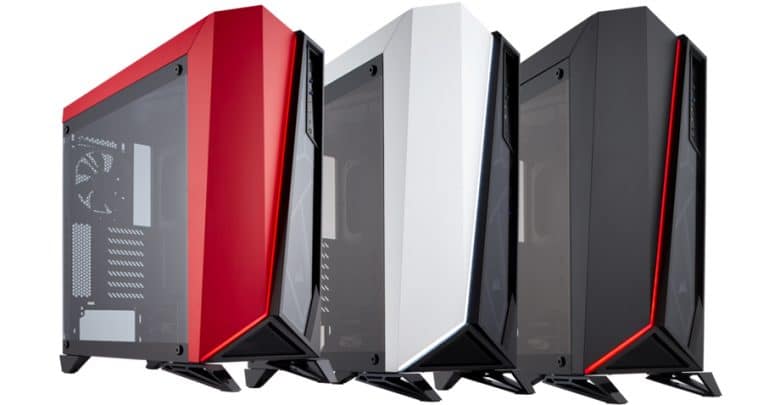
Corsair added another case to its Carbide series earlier this year. The SPEC-OMEGA is the successor of the SPEC-ALPHA, as you can easily see from the design. For about 25 Euro surcharge there are some new features, whether the case with the eye-catching front is suitable for 100 Euro something, you can read in our test.
Design
The most conspicuous feature of the SPEC models is the front. The separation of black and white is freshened up by an LED stiffener. This structure also extends over the lid and is a real eye-catcher. Corsair collects points directly for fans of such designs. In the right, black part of the front is also the I/O panel, which is super fitted.
Probably the biggest difference to the SPEC-ALPHA is the glass side panel. It provides a larger view into the case than its predecessor. Plastic was also used there. The four screws can be easily removed with a hexagonal wrench – provided you have the appropriate hexagonal wrench at hand.
The size of the lid has also developed positively. Just like the front, it’s easy to remove. Due to the greater distance to the actual case, fans can now also be installed on top of the case.
In general, the SPEC-Omega provides a visually very appealing sight. The front and the lid have a striking design and the LED strip sets beautiful accents. The large glass side makes it even more visible, as the inside is also illuminated. Behind the panel hides a LED fan. Customizable LEDs would have been a bit better with the black/white design. Corsair has recently announced the SPEC-OMEGA RGB, what a coincidence!
Workmanship & Scope of Delivery
Not too much is included in the delivery. The typical mounting screws, nicely sorted into different packages, a few cable ties for laying the cables in the case and a manual. Of course, the matching hexagon wrench for the glass element is included.
The SPEC-OMEGA is our first case from Corsair, but we still hoped for the usual quality. We weren’t disappointed. The front in particular suggests that at least the gap mass is not one hundred percent accurate. Wrong thought, we’ll find the usual Corsair quality. There are no unpleasant edges and also the LED strip of the front glows evenly. The I/O panel looks a bit cheap due to the plastic, a mesh grid would certainly have done the fan behind it good.
Three 2.5-inch data carriers can be installed on the back of the mainboard tray. The mechanism that holds the hard drives seems a bit cumbersome. Inserting the hardware works perfectly, removing it is more difficult. All too often one does not change his data carriers in the case however now also.
| Housing type | Midi Tower |
| Dimensions ( H x W x D) | 516 x 232 x 495 mm |
| Net Weight | approx. 7.56 kg |
| Material | Tempered Glass, Plastic, Steel |
| Color | Black/White |
| Data carrier |
|
| Fans, pre-installed |
|
| Possible number of fans / radiators | fan:
Radiators:
|
| Motherboards | E-ATX, ATX, Micro-ATX, Mini-ITX |
| I/O Connections |
|
| Power supply unit | Standard ATX up to 200 mm |
| Maximum graphics card length | 370 mm |
| Maximum CPU cooler height | 170 mm |
Inside Construction of the Corsair SPEC-OMEGA
The mentioned slot of the 2.5 inch data carrier behind the mainboard tray is another highlight of the SPEC-OMEGA. Due to the special insert, tool-free assembly is possible. Removal proves to be a little fiddly. As mentioned before, you probably won’t change your hardware every day. The 3.5-inch drive can also be installed without tools. It is also possible to completely remove the hard disk cage.
Various openings are available for cable management. These are large enough to accommodate a larger number of cables. Rubber rings were attached to protect the cables. For the cable routing there are only holders to tighten the cable ties properly, a proper cable routing or at least a small guide channel would be desirable at this price. At least the cables from the I/O panel are black and can easily be hidden.
The Corsair SPEC-OMEGA offers more than enough space for radiators. A 360 mm radiator can be placed in the front, while a 280 mm radiator can be mounted on the lid at the same time. Wouldn’t that be the problem with the cables? Obviously, manufacturers are relying on more and more users to use a modular power supply. With a non-modular power supply, space is limited when the hard disk cage is installed.
In the area of the power supply there is of course a dust filter which can be easily removed and thus cleaned. So that the vibrations of the power supply unit are not transmitted to the entire housing, the tray is rubberized to minimize vibrations.
There is enough space for graphics cards, because our Gigabyte GTX 1060 with 6GB from Aorus* can be installed perfectly. Included in the package are a Ryzen 5 1400*, 16GB memory from Ballistix* and a MSI B350 PC Mate*.
Conclusion on the Corsair Carbide Series SPEC-OMEGA Midi Tower
The eye-catching design of Corsair’s SPEC models makes another leap forward with the SPEC-OMEGA. The LED strip installed in the front looks great and upgrades the case a whole bar. Another interesting feature is the slide-in frame for the 2.5-inch data carriers, which can be installed completely without tools.
The housing offers a lot of space for radiators, even in this midi tower two radiators find their place. However, there is a lack of this in the area of the power supply unit. Only if the hard disk cage is removed, the cables can be laid well – at the moment they are rather stuffed in.
At a price of almost 100 Euros you get typical Corsair quality, workmanship defects are scarce. Only in the area of cable management would we have wished for a little more. However, one can see beyond this circumstance.
Corsair SPEC-OMEGA
Workmanship
Design
Features
Damping
Cooling
Value for Money
Chic design
The Corsair SPEC-OMEGA offers a great design and plenty of room for fans and radiators. Swabs still have to be made.



